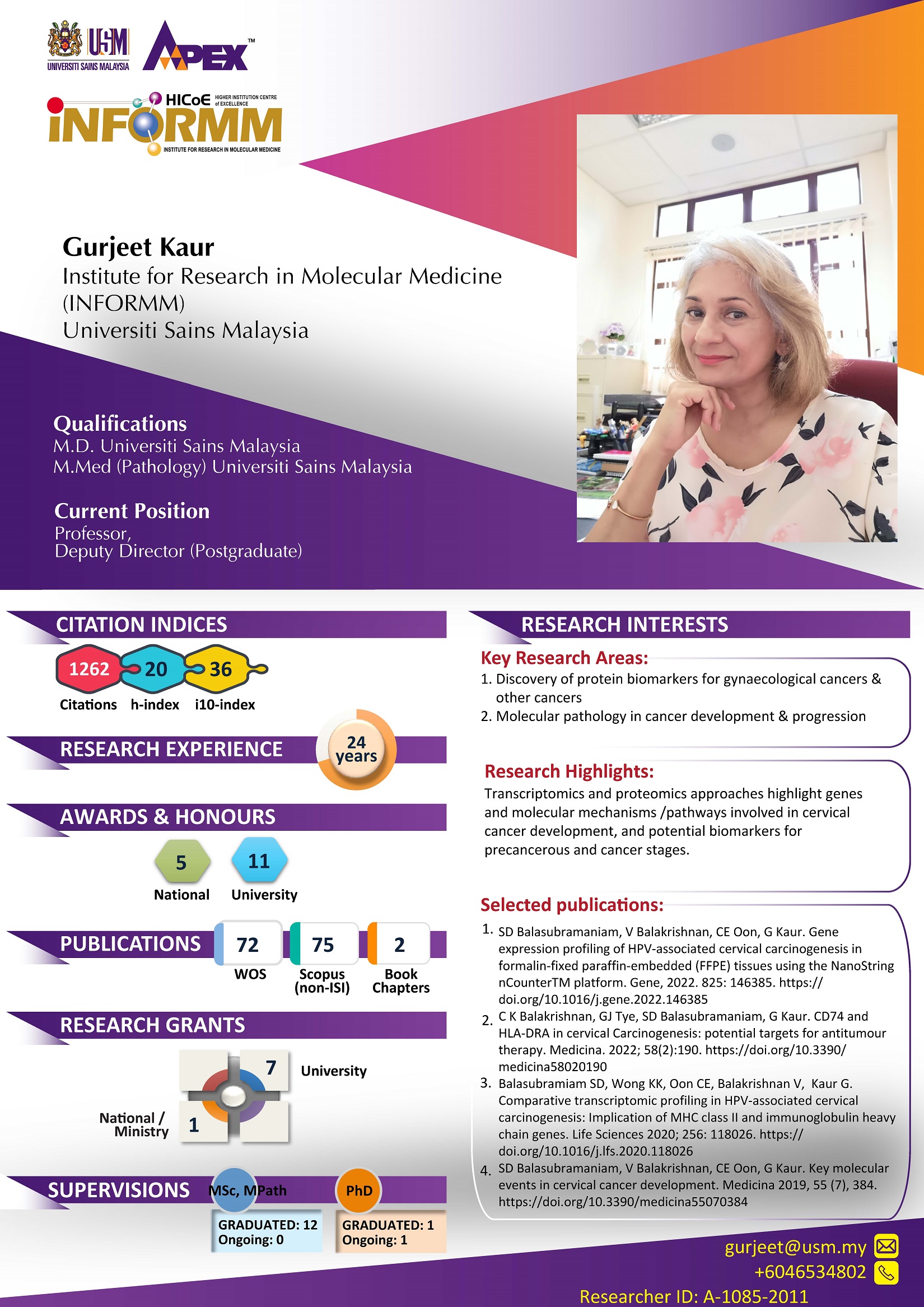Gurjeet Kaur Chatar Singh

Name
Gurjeet Kaur Chatar Singh
Current Position
Professor
gurjeet@usm.my
Office Telephone
+604-6534802
Qualifications
M.D., Universiti Sains Malaysia, 1989
MMed(Pathology), Universiti Sains Malaysia, 1996
Affiliations
A.M. Academy of Medicine of Malaysia
Malaysian Medical Association
International Academy of Pathology, Malaysian Division
Malaysian Society of Gastroenterology and Hepatology
Research Interests
Pathology, Cancer, Colorectal cancer, Gynaecological cancers, Molecular pathway
Research Overview 1
Genomic expression profile of human papilloma virus (HPV) 16 and 18-associated pre-cancerous lesions and cancer of the cervix
High risk human papilloma virus (HPV) 16 and 18 are implicated in the development of precancerous lesions (cervical intraepithelial lesions (CIN)) and cancers of the cervix. The E6 and E7 viral oncogenes are integrated into and form stable associations with the host cell genome, affecting the cell cycle, ultimately causing infected cells to become immortalized and transform into neoplastic cells.
We have determined the differential mRNA expression profile between normal cervix, HPV-associated CIN 1 (low grade squamous intraepithelial lesion, LSIL), CIN 2/CIN 3 (high grade squamous intraepithelial lesion, HSIL), and carcinoma of cervix from formalin-fixed paraffin embedded tissue. We are investigating the expression of up-regulated and down-regulated host proteins in relation to molecular pathways in disease progression, as well as the interaction of of these host proteins with HPV 16 and HPV 18 E7 oncoprotein.
Research Overview 2
MALDI Mass Spectrometry Imaging on formalin-fixed paraffin-embedded tissue for various gynaecological cancers
Extensive research is done to identify biomarkers for use in early cancer detection, diagnosis, prognosis and monitoring therapeutic responses. There are various platforms to study biomarkers which include genomics, proteomics and metabolomics. Majority of the methods use fresh tissue or bodily fluids and compare differential patterns between normal and cancer. Formalin-fixed paraffin embedded (FFPE) tissue is routinely used for histopathology evaluation and diagnosis in pathology laboratories. It is easily available and provides a source of invaluable material namely DNA, RNA and protein for experiments on biomarker identification. Protein is often extracted from whole tissue samples, which is then analyzed by various methods, and results compared between cancer and normal samples. Relatively few models allow spatial information of a biological molecule with preservation of tissue morphology. Immunohistochemistry is one of these techniques. It is based on antibody directed towards a specific cancer antigen in FFPE tissue sections. It gives semi-quantitative determination of protein expression but is dependent on availability of antibodies for known antigens. A more recent and sensitive technique, matrix-assisted laser desorption/ionization (MALDI) mass spectrometry imaging (MSI), acquires a more comprehensive proteomic analysis than immunohistochemistry. The spatial distribution and intensity of hundreds of peptides corresponding to proteins of interest can be evaluated from a single FFPE tissue section, which can be used for prediction of disease severity. We are conducting collaborative research with a proteomics expert in Australia.
Research Overview 3
Selected Publications
1. Matthew T. Briggs, Yin Ying Ho, Gurjeet Kaur, Martin K. Oehler, Arun V. Everest-Dass , Nicolle H. Packer, Peter Hoffmann. N-glycan matrix-assisted laser desorption/ionization mass spectrometry imaging protocol for formalin-fixed paraffin-embedded tissues. Rapid Commun. Mass Spectrom. 2017, 31, 825-841.
2. Mohd Nizam Zahary, Ravindran Ankathil, Maya Mazuwin Yahaya, Sharifah Emilia Tuan Shariff & Gurjeet Kaur. Protein expression profiles of deoxyribonucleic acid mismatch repair genes: Association with clinicopathological characteristics of Malaysian Lynch syndrome patients, Journal of Histotechnology, 2017, 40:1, 13-20,
3. Balakrishnan Kunasundari, Carlos Rodriquez Arza, Frans H.J. Maurer, Vikneswaran Murugaiyah, Gurjeet Kaur, Kumar Sudesh. Biological recovery and properties of poly(3-hydroxybutyrate) from Cupriavidus necator H16. Separation and Purification Technology. 2017, 172: 1-6.
4. Arun V. Everest-Dass, Matthew T. Briggs, Gurjeet Kaur, Martin K. Oehler, Peter Hoffmann and Nicolle H Packer. N-Glycan MALDI Imaging Mass Spectrometry on Formalin-Fixed Paraffin-Embedded Tissue Enables the Delineation of Ovarian Cancer Tissues. Molecular and Cellular Proteomics. 2016, 15: 3003-3016.
5. Parul Mittal, Manuela Klingler-Hoffmann, Georgia Arentz, Lyron Winderbaum, Noor A Lokman, Chao Zhang, Lyndal Anderson, James Scurry, Yee Leung, Colin JR Stewart, Jonathan Carter, Gurjeet Kaur, Marthin K Oehler and Peter Hoffmann. Lymph node metastasis of primary endometrial cancers: Associated proteins revealed by MALDI imaging. Proteomics 2016 Jun;16(11-12):1793-1801.
6. S Vigneswari, V Murugaiah, G Kaur; HPS Abdul Khalil, AA Amirul. Biomacromolecule immobilization: grafting of fish-scale collagen peptides onto aminolyzed P(3HB-co-4HB) scaffolds as potential wound dressing. Biomedical Materials 11 (2016) . doi:10.1088/1748-6041/11/5/055009.
7. Parul Mittal, Manuela Klingler-Hoffmann, Georgia Arentz, Chao Zhang, Gurjeet Kaur, Martin K. Oehler and Peter Hoffmann. Proteomics of endometrial cancer diagnosis, treatment and prognosis. Review. Proteomics Clinical Applications. 2016,10(3):217-229.
8. Mohd Nizam Zahary, Abdul Aziz Ahmad Aizat, Gurjeet Kaur, Maya Mazuwin, Ravindran Ankathil. Polymorphisms of cell cycle regulator genes CCND1 G870A and TP53 C215G: Association with colorectal cancer susceptibility risk in a Malaysian population. Oncology Letters 2015, 10: 3216-3222.
Author Address

